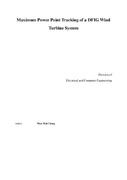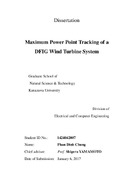
Vui lòng dùng định danh này để trích dẫn hoặc liên kết đến tài liệu này:
http://thuvienso.dut.udn.vn/handle/DUT/1926| Nhan đề: | Maximum Power Point Tracking of a DFIG Wind Turbine System | Nhan đề khác: | Tìm điểm công suất cực đại của tua bin gió sử dụng DFIG 学 位 論 文 概 要 |
Tác giả: | Phan, Dinh Chung | Từ khoá: | Wind Turbine System;Hệ thống tua bin gió;Maximum Power;Công suất cực đại;DFIG | Năm xuất bản: | 6-thá-2017 | Nhà xuất bản: | Kanazawa University, Japan | Tóm tắt: | Doubly-fed induction generator (DFIG) has been used popularly in variable speed wind turbines because the DFIG wind turbine uses a small back-to-back converter to interface to the connected grid, about 30% comparing to the wind turbine’s capacity, and provides a control ability as good as a variable speed wind turbine using a generator with a full converter. The most important purpose of a variable speed wind turbine or a DFIG wind turbine, in general, is to utilize fully wind energy for electric generation. To meet this objective, several publications provided different methods. Generally, the previously proposed schemes can be listed into two groups such as wind speed-based method and wind speed sensorless one. With the first group, the wind turbine can give a good performance in tracking maximum power point but it requires a precise and instantaneous wind speed measurement; this requirement hardly achieve in practice. With methods in the second group, an anemometer does not require but the wind turbine using these methods cannot track maximum power point efficiently under varying wind conditions. In this dissertation, I proposed two methods and control laws for obtaining maximum energy output of Doubly-fed induction generator wind turbine. The first method aims to improve the conventional MPPT curve method while the second one is based on an adaptive MPPT method. Both methods do not require any information of wind data or wind sensor. Comparing to the first scheme, the second method does not require the precise parameters of the wind turbine. The maximum power point tracking (MPPT) ability of these proposed methods are theoretically proven under some certain assumptions. In particular, DFIG state-space models are derived and control techniques based on the Lyapunov function are adopted to derive the control methods corresponding to the proposed maximum power point tracking schemes. The quality of the proposed methods is verified by the numerical simulation of a 1.5-MW DFIG wind turbine with the different scenario of wind velocity. The simulation results show that the wind turbine implemented with the proposed maximum power point tracking methods and control laws can track the optimal operation point more properly comparing to the wind turbine using the conventional MPPT-curve method. The power coefficient of the wind turbine using the proposed methods can retain its maximum value promptly under a drammactical change in wind velocity while this cannot achieve in the wind turbine using the conventional MPPT-curve. Furthermore, the energy output of the DFIG wind turbine using the proposed methods is higher compared to the conventional MPPT-curve method under the same conditions. |
Mô tả: | Doctoral thesis. Major: Electrical and computer engineering; 73 pages |
Định danh: | http://thuvienso.dut.udn.vn/handle/DUT/1926 |
| Bộ sưu tập: | LA.Kỹ thuật điện |
Các tập tin trong tài liệu này:
| Tập tin | Mô tả | Kích thước | Định dạng | Đã có tài khoản, vui lòng Đăng nhập |
|---|---|---|---|---|
| PhanDinhChung.TT.pdf.pdf | Tóm tắt | 251 kB | Adobe PDF |  |
| PhanDinhChung.TV.pdf.pdf | Toàn văn | 913.15 kB | Adobe PDF |  |
Các đề xuất từ CORE
Khi sử dụng các tài liệu trong Hệ thống quản lý thông tin nghiên cứu phải tuân thủ Luật bản quyền.